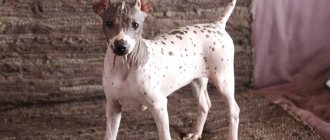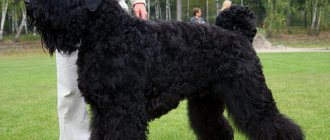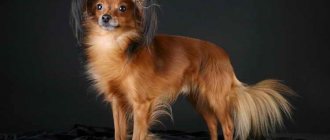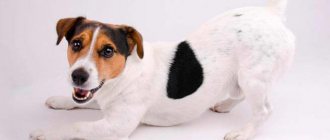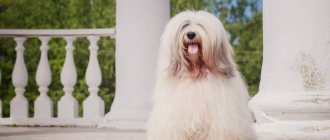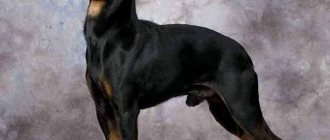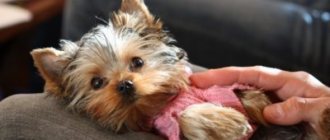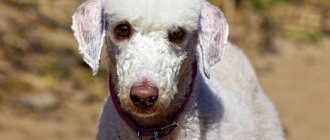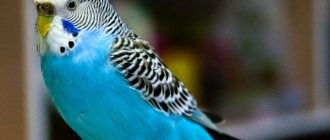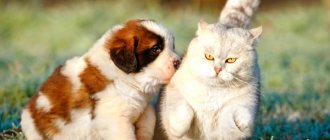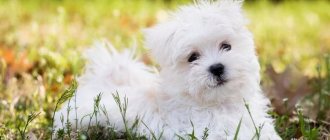Breed characteristics
| Short description | |
| Origin: | Great Britain |
| Conditions of detention: | Apartment |
| Purpose: | Hunting, companion |
| Color: | Red, wheaten, blue and tan, grizzly and tan (dark grey) |
| Wool length: | Short |
| Adult dog size: | The height at the withers is not described by the rules, on average it is 28-35 cm; weight of males – 5.9-7.1 kg, females – 5.1-6.4 kg |
| Average life expectancy: | 13-15 years old |
| Walk: | 2 to 3 times a day |
| Physical activity needs: | High |
| Fédération Cynologique Internationale (FIC) classification: | Group No. 3 Terriers Section No. 1 Large and medium-sized terriers |
| Puppy price: | 20,000-60,000 rub.
|
Bull Terrier
The Bull Terrier is a powerful, stocky dog with a muscular build and a unique muzzle shape. This is one of those dogs whose external aggressive appearance turns out to be deceptive, since the character of the Bull Terrier is kind and flexible.
The breed was bred in England in the mid-19th century to participate in dog fighting. Since then, its popularity has not waned.
Bull Terriers have a strong, harmonious build with a deep, broad chest and prominent ribs. The head is strong, long, egg-shaped, low set. Muzzle with a strongly developed lower jaw. The eyes are set obliquely, narrow in section, triangular in shape. The ears are small and erect. The limbs are strong and muscular, parallel.
The animal has short fur. The color is white and colored.
According to the standard, a bull terrier should have a height of no higher than 35.5 cm and a weight of 8-13 kg.
Those who are planning to purchase a representative of this breed need to know that the dog is very loyal, friendly, playful, loyal to children, and balanced. However, all these qualities can be achieved only with early socialization and proper education. The dog is suitable for keeping in an apartment, but not for inexperienced and lazy owners. Physical activity and long walks are mandatory for him.
The lifespan of bull terriers is 11-13 years. Prices for puppies start at $250 and can exceed $1,100.
History of the origin of the species
The first mentions of borders date back to the 19th century. Dogs of this type were described in the book “Dogs of the British Isles”, and were also presented in a painting depicting a hunt with a pack. The first animals of this species appeared on the border of Scotland and England, in the Northumberland region. This is what gave the breed its name, because border in English is border (border). The name was officially assigned to the dogs in 1880.
They were used to hunt badgers, foxes, rodents and otters. The animals had to keep up with the horses and hounds. The goal of breeding was to create dogs resistant to any weather, cold and wind.
For a long time, the owners did not want to register the new species with the English Kennel Union, as they believed that this would spoil the working qualities of their pets. It was not until 1920 that Border Terriers were recognized, and at the same time a British fan club for the breed was created.
Kern
The Cairn Terrier comes from Scotland. There it was used to hunt foxes and rodents. These dogs have a stretched body, a small head proportional to the body, which is located on a strong-looking neck. At the withers they reach 28-31 cm, in weight - 6-7.5 kg. Their ears are small and pointed. The eyes are oval, lively. Limbs are short and strong. The front legs are larger than the hind legs.
The body of Cairn Terriers is covered with coarse, thick hair with a soft undercoat. Characteristic colors: gray, red, fawn, brindle.
The main characteristics of representatives of this breed: intelligence, energy, courage, perseverance, self-confidence, devotion, sociability, selfishness, fearlessness. They can serve as good watchmen and protectors. Raising and training Cairn Terriers is easy.
With proper care and compliance with maintenance recommendations, Cairn Terriers live 12-15 years. Breeders value puppies at $700-1000.
Distinctive features
All dogs of this species, according to the standard adopted by the FCI (FCI) of 1998, must meet the following parameters:
- The skull is of medium width, with a shortened muzzle that is similar in appearance to the head of an otter.
- Bite - scissors, let's say straight. Overshot or undershot is a serious fault.
- The nose is black (let's say liver or flesh tone).
- The eyes are dark and lively.
- Neck of moderate length.
- The ears are small in size, of medium thickness, hanging down on the sides of the head, fitting well to the cheekbones, reminiscent of the English letter “V”, always directed forward.
- The tail is carried high and usually carried high, but not carried over the back. The length is moderately short, the thickness is well defined at the base, tapering slightly towards the tip.
- The body is elongated, narrow, deep, muscular. The ribs are well stretched back, but slightly curved.
- The legs are muscular, strong, straight, long enough, but the bones do not look heavy. Movements are easy. The paws are small, with thick pads.
- Two layers of wool The undercoat is very dense, similar to felt. The top hair is moderately short, thick and coarse. There is a small “beard” and “eyebrows”.
Boston
The Boston Terrier breed originated in the United States in the 19th century, mainly from fighting dogs. Nevertheless, in character they are in no way like their ancestors. These small dogs, 23-38 cm tall and weighing 6.8-11 kg, resemble bulldogs with their muzzles and terriers with their bodies. Their muzzle is square, with a well-defined forehead, dark round eyes, medium-sized, erect, high-set ears, and a square, strong jaw. The head is placed on a high neck. Limbs are short and strong.
Boston Terriers are shorthaired and have no undercoat. The color of the coat is black and white, black and brown, and brindle.
Boston Terriers are cheerful and playful, gentle with their owners, independent, sometimes stubborn, and require socialization and early education. They get along great with children. They are suspicious of strangers, so they make good guards.
The lifespan of Boston Terriers is 12-15 years. Breeders estimate babies at 500-1700 dollars.
Did you know? The Boston Terrier is one of the twenty most popular breeds among Americans. In 1979, it was recognized as the official symbol of the state of Massachusetts.
.
Photo of an adult dog
Bedlington Terrier
The dog has the appearance of a sheep. This likeness of a lamb weighs 8-10 kg and grows up to 40 cm. Two centuries ago it was considered a good hunting dog. But the aristocracy saw exceptional decorative features in the dog and Bedlingtons began to turn into companions.
Later, already in the 20th century, connoisseurs of these dogs came to their senses and began to develop the working, hunting branch of the breed. Today, these terriers are poorly distributed. The price of purebred Bedlington Terriers is very high. By owning these dogs, people demonstrate a high level of well-being and belonging to the aristocracy.
Photos of puppies
Irish Terrier
Before arriving on the emerald island of St. Patrick (in the 5th century), the Irish Terrier breed already existed. This is what the locals say. This is most likely a legend. But the breed really has a long history. The first dog show at which Irish terriers were shown took place in Dublin in 1873.
The dog is very versatile. Weighs about 11 kg and grows up to 50 cm. Life on a farm, functioning as a hunter, watchman and even a shepherd, is a common thing for the Irish Terrier. But its compact size and flexible nature allow it to settle comfortably in city housing.
Features of character and behavior
The Border Terrier is an active and obedient animal if its energy is given the right outlet. For a family with teenage children, he will be an ideal companion.
Advantages
- The Border is a fairly balanced dog, at the same time very attached to the owner and obedient, which makes him an excellent pet.
- He always tries to be unobtrusively present next to the owner or members of his family.
- He will be happy to play and run with children, as he is naturally active and energetic.
- His hunting background makes him susceptible to training and obedience to the owner, the dog will try to please him. Since they were usually used to chase animals in a pack of several individuals, Borders became one of the most tolerant of other people's dogs, if we consider the terrier family. They themselves will not provoke fights on the street.
- This is a brave and courageous dog, although it is not a guard, it will always try to drive away an intruder from its owner by barking. At the same time, in a calm environment, the dog rarely uses his loud voice.
Flaws
Dogs are very attached to the company of people, therefore, with a lack of attention, or if they are constantly alone, terriers can show all the destructive traits of their personality . The same situation will arise with a lack of physical and mental stress.
Dogs of this breed love to chew things, jump into places where they are not allowed, and also dig holes in any surface, be it the ground or a mattress. It is advisable to buy them various toys and bones that will distract them from destructive actions and wean them from harmful tendencies from childhood.
A love of digging and jumping can encourage a pet to escape if the area of the house or playground has problems with fencing. Although this is one of the most peaceful terriers towards its relatives, representatives of the breed do not really like dogs of the same sex, especially if they show aggression. The borderer himself will not start the conflict, but will always respond.
In addition, the hunting background imposes a ban on keeping small animals in the same apartment with a representative of the breed - hamsters, rats, ferrets, and so on. They get along with cats in different ways; some terriers treat them well, especially if they have lived together since childhood, but dogs most often perceive street and neighborhood pets as potential prey.
Despite the fact that, in principle, dogs love to play with children, they will not tolerate careless handling and intrusiveness, so it is undesirable to leave dogs alone with children.
Description of Border Collie
Canine ratings based on scientific research call the Border Collie the smartest dog breed. And boarders fully confirm this thesis in practice. They work not only as shepherds: they serve in the police, become guides for the blind, pet therapists for people who have experienced severe stress, and simply excellent companions for their owners who lead an active lifestyle.
The FCI standard assigns the breed an individual number 297 and classifies it in the first group (“Shepherd and cattle dogs”), in the first section (“Shepherd dogs with working tests”). The latest updates to the standard date back to 2009.
Appearance
Border owners consider their appearance to be ideal, and they are indeed very harmonious, well-proportioned dogs, full of charm and positivity.
These are very beautiful and harmonious dogs
Table: Border Collie breed conformation according to FCI standard
| Main articles | Description |
| Dimensions |
|
| Addition |
|
| Head |
|
| Limbs |
|
| Tail |
|
| Wool |
|
| Colors |
|
Working Border Collies have developed a special, creeping gait
The peculiarity of the breed also lies in its movements: only border dogs can run at a swift, creeping trot, almost hugging the ground. Almost exactly the same way a cat moves, silently approaching its prey.
Photo gallery: some border collie color options
Zoned gray color variants are quite rare in the breed
With a blue color, not only white spots are acceptable, but also tan
This is a rare, short-haired blue merle color that shares the same standard with the long-haired variety.
Blue eyes are allowed for any merle color; for other colors the eyes must be brown.
If the Border Collie has a chocolate color, it is also acceptable to have a tan color.
With lilac coloration, the eyes may be amber-yellow.
Border collies of a blue merle tricolor color look unusually elegant
The golden-white color looks sophisticated and elegant.
Black and white individuals are currently the most common in the breed
In black tricolor dogs, the tan can be either pure red or brindle.
For a border collie, the brown merle color can be called exclusive - it is so rare
Character and behavior
They are smart, cheerful and efficient, which makes them better than many other breeds. But sometimes owners suddenly notice with amazement that their pet seems to have been replaced: he has become wayward, uncontrollable and disobedient, and when left alone at home, he completely destroys the apartment: he chews and breaks things, although he has long since left puppyhood. What's happened?
The Border Collie is playful, creative and very active.
In this case, as in all similar cases, the dog is not to blame. The owner is to blame, because for some reason he began to pay less attention to his pet. Border does not understand why this happened, he is nervous, bored and tries to attract attention to himself in every way possible.
This is a very affectionate and completely non-aggressive dog. He adores his owner and his entire family, gets along well with small children, although he can frighten them with his excessive activity. He gets along well with dogs of any breed and size, but other small animals - cats, rodents and birds - are best not placed in the same house with him: the border dog may show too much interest in them.
Disqualities and dog disadvantages
Aggressiveness or, conversely, cowardice of a dog is a reason for its disqualification at the exhibition and removal from breeding work. As for the exterior, the disqualifying defect is most often the color, or more precisely, the dominance of white in it.
A dog of this color will be disqualified from the exhibition, however, in kennels that deal with working dogs, piebald border collies are often found
Care and maintenance
The Border Terrier's coat does not require special care. Due to its structure, the cover is almost impervious to water and dirt, dogs feel great in rain and cold. The breed is healthy, but some diseases may occur.
It is better to keep borders in an apartment, possibly a private house with a backyard for walking.
The claws are trimmed a couple of times a month, the ears are inspected daily, especially in the summer, keeping an eye out for mites and inflammation. Eyes are washed if necessary, teeth are cleaned weekly.
Nutrition
Representatives of the breed love to eat and can gain excess weight. In addition, food allergies are common in dogs. Therefore, you should strictly measure the volume of portions, control the calorie intake, and minimize treats. It is advisable to limit the consumption of cereals, potatoes, and bread . It is better to introduce all new products gradually and in small quantities, carefully monitoring the pet’s condition.
You can feed Border Terriers both natural food and professional food. You should not mix both types of nutrition, as this will lead to gastrointestinal and liver diseases. It is better to buy premium or super-premium brands, they contain natural ingredients and vitamins.
You should choose food that is high in protein, as this is an active breed. Brands with hypoallergenic composition are also recommended.
The basis of a natural diet should be lean meat and offal. Boiled sea fish, without bones, may be present. It must be remembered that it can become a source of allergies.
The menu may contain:
- Porridge;
- Bouillon;
- Vegetables;
- Fermented milk products;
- It is recommended to give your dog boiled eggs 1-2 times a week (if the product is well tolerated);
- Cottage cheese.
Bones, especially tubular ones, are completely prohibited, as are fatty, fried, spicy, and sweet foods from the table.
The number of meals depends on the age and condition of the pet, you can focus on the following intervals:
| Age, months | How often to feed, once/day |
| 1-2 | 6-7 |
| 2-4 | 5 |
| 4-6 | 4 |
| 6-10 | 3 |
| from 10 | 2 |
We recommend that you read a detailed article on the topic: “How and what to feed a dog: types and characteristics of nutrition.”
Health
The breed is quite healthy, but has a predisposition to certain diseases.
Vaccinations
Terriers are vaccinated with a complex vaccine that works against several diseases at once. A week before the procedure, the dog must be treated for helminths. Adult dogs are vaccinated once a year , children - twice (the timing of vaccination for puppies differs depending on the drug, but usually it is 8 and 12 weeks).
After the procedure, little border dogs are subject to a 2-week quarantine, during which their health needs to be monitored and walking is prohibited.
Vaccination minimizes the risk of the following diseases:
- rabies;
- coronavirus;
- parovirus enteritis;
- plague;
- parainfluenza;
- hepatitis;
- leptospirosis;
- trichophytosis.
Important article on the topic: “Everything you need to know about dog vaccinations.”
Diseases
Terriers are prone to certain diseases. Among them:
- Dysplasia of the hip or elbow joint. The disease is congenital, manifesting itself after 15 months. in the form of stiffness of movement, pain, and can lead to immobility.
- Cataract. Impaired transparency of the lens, leading to decreased vision. The surface of the eye is cloudy, bluish-gray.
- Epilepsy, Spike's disease. Manifests itself in the form of convulsive seizures against the background of congenital disorders of brain functioning.
- Spongiform leukoencephalomyelopathy. It manifests itself in puppies with severe trembling when moving. Most babies are subject to euthanasia due to impaired quality of life.
- Puppy ataxia is genetic. A practically incurable disease, it manifests itself in uncoordinated and unsteady movements, falls, and ocular nystagmus. Leads to complete immobilization and inability to eat.
- Retinal atrophy. A genetic problem leading to almost complete loss of vision receptors and blindness.
- Cryptorchidism. A congenital anomaly in which one or both testicles in a male do not descend to their proper place.
Also, pets often experience obesity and allergic manifestations.
Walk
Border Terriers require active walking for at least 2 hours a day. They don't like to lie on the couch; they need to run, jump, and swim. Considering their abilities, we can recommend participation in agility, coursing and other dog competitions. They will also be happy to run after the Frisbee disc and ball.
Dogs have previously accompanied riders on horseback while hunting, so they will enjoy running behind their owner on roller skates or a bicycle at a not very high speed.
Dogs are prone to running away, especially if they notice “prey”, so it is better to keep them on a long leash. Free walking is possible only if the command “Come to me” is absolutely followed, as well as in the absence of conflicting dogs nearby.
You should not walk your pet near neighbors' flower beds or in parks, as the dog can dig up everything.
Grooming
The Border Terrier's coat is easy to care for. It is enough to comb it once a week. Shedding is weakly expressed, since in order to remove dead hair it is necessary to trim the animal. The procedure is carried out 2-3 times a year , avoiding winter time. To determine whether your pet needs trimming, you need to pull a small tuft of fur towards you. If it is easily pulled out, then the hair has already died off; healthy hair cannot be removed in this way.
For show animals, trimming and grooming requires more attention and the use of special tools. The main steps are as follows:
- Ears. Should look smooth, hair should be plucked from the entire surface. The contour is processed with scissors, the area of the ear canal is cleared of hair with tweezers.
- Beard. Dead fur is plucked out. They follow the contour with scissors, slightly rounding it.
- Back. All dead hair is removed straight and evenly.
- Frame. All protruding or too long hairs are removed, the rest is combed.
- Neck. The hair is plucked and removed in such a way that a smooth transition is formed, without “dips” and “hills” at the withers.
- Lower chest area. Here a smooth flow is formed to the abdominal line using trimming tools or scissors.
- Front chest. An “arc” is formed and all long and protruding hair is removed.
- Belly line. Smoothed using tools.
- Hips. The internal zone is processed with thinning scissors. The outer part and “pants” are cleaned of protruding hair. The outer area should look completely smooth.
- Front legs. The back of the limbs is plucked short; no long hairs should remain on the elbows.
- Paws. The wool is cut in a circle with scissors. It is necessary to form a contour so that the claws become visible, to make the limb look like a cat's paw.
- Tail. Long hairs are removed from the upper and lower zones. The contour is given the shape of a “carrot”, slightly narrowing it towards the tip, which is rounded.
Dogs are bathed rarely enough so as not to wash off the protective layer from the surface of the coat. The rest of the time, it is enough to wipe the contaminated areas with a damp cloth or rinse with water without shampoo and soap. It is permissible to use a furminator, but in limited quantities.
Border Collie diseases
Working border dogs are unusually hardy - it is estimated that in one “work shift” such a dog can run a total of up to eighty kilometers. And the life expectancy of this breed is the envy of many others: with proper maintenance, they can please their owners for fifteen or even more years.
The popularity of the breed has led to uncontrolled matings and frequent manifestations of hereditary pathologies
Health problems are not typical for working lines that were formed against the background of almost natural selection in harsh climatic conditions. Commercial breeding, the “fashion” for borders and their high cost have led to negative consequences - frequent manifestations of genetic pathologies, including the following:
- hip dysplasia;
- progressive retinal atrophy;
- epilepsy;
- collie eye abnormality;
- allergy;
- osteochondrosis dissecans.
Now all these problems can be identified in advance, at the level of genetic testing, so as not to use sires with poor heredity in breeding. Comprehensive testing does not reveal only one annoying problem of the breed - alopecia, when the dog’s ears do not cover six and remain bare. But this is still a cosmetic defect, and not a health hazard.
A much more serious disease is dysplasia of the elbow and hip joints - in recent years, this pathology has increasingly appeared in border collies, despite their very modest size. Moreover, a sick puppy can be born to a couple with very strong, regular joints. However, almost half of these diseases are caused by improper raising of the dog. Here's what the owner needs to pay attention to.
- high-quality balanced diet - if you do not have sufficient knowledge to competently build a natural menu, give preference to ready-made food for puppies and juniors, choose products only from super-premium and holistic classes;
- if you suspect weak joints, contact your veterinarian - he will prescribe mineral supplements with glucosamine and chondroitin;
- avoid excessive stress on the paws during the period of active growth of the puppy - from three to six months;
- Slippery floors are very dangerous while the baby’s bones and joints are developing.
Unfortunately, preventive measures may not be enough. If after four months of age your little Border begins to limp after sleeping, take him to the vet immediately and have him x-rayed. A diagnosis of “dysplasia” is not a death sentence: there are effective medicinal and, in extreme cases, surgical treatment methods that will allow your pet, if not a complete recovery, then to live a long and fairly comfortable life.
Video: everything about the border collie breed
Mating
The first mating is carried out no earlier than 1.5 years (for males 1 year), although it is advisable to wait until 2-2.5, which is when the dog reaches full maturity. To select a match for your pet, the owner needs to contact the kennel club or directly to the owner of a suitable candidate.
Parents are selected taking into account that the advantages of one compensate for the disadvantages of the other, and all the positive characteristics are only enhanced in the future offspring.
Both members of the pair must have sufficient show scores for breeding that confirm their suitability for the future goal. Parents must have age-appropriate vaccinations and be treated for helminths. At the first meeting, the female is brought to the male’s territory, mating is repeated 1-2 more times with an interval of about a day.
Read a detailed article on the topic: “Everything you need to know about breeding dogs: appropriate age, what to do if it doesn’t work out, rules and tips.”
American Hairless Terrier
An extravagant breed with a wide range in height, short hairless terriers do not exceed 25 cm, tall ones reach 46 cm. In addition, despite the name, the hairless terrier is not prevented from acquiring short, clinging hair. Hairless individuals have very smooth, warm skin.
Animals with hairless skin are considered the most hypoallergenic. But they have other problems caused by the lack of natural protection of the body. Hairless dogs must be protected from sunlight and cold water. Hunting work with such a body is also difficult.
Key points in training
Terriers are very smart, love to work and fulfill the wishes of the owner, so they are easy to train. Considering that border babies mature slowly, it is better to use a game strategy when teaching. Training should begin from the moment the pet appears in the house, paying special attention to the commands “Come to me” and “No”.
Like all terriers, Borders are stubborn and try to dominate. Therefore, training must be persistent; the pet should not be allowed to decide whether he will follow the command or not.
Read about how to properly train a dog in the article: “Training a puppy: effective methods from dog handlers, learning commands at home.”
You should not shout or hit the dog if it refuses to complete tasks and is offended by the owner. It is better to use the most interesting and varied tasks that will make the animal think, reinforcing the execution with praise, stroking, and treats.
Terriers can also be used for hunting; the working qualities of the representatives of the breed are not lost. Preparation begins from an early age, and before taking part in the process for the first time, it is necessary to make sure that the animal responds to the owner’s call and is able to withstand the load. It is advisable to provide your pet with an address card and a chip in case of loss.
Australian Terrier
Compact dog, height 25.5 cm, no more. Build common among short terriers: somewhat elongated body, short legs. The coat is straight, the outer coat is hard, about 6 cm, the undercoat is moderately thick and short. Various colors: gray, blue, sand, red. He has a surprisingly smart, meaningful look.
The breed is the result of artificial selection. It is assumed that the breed is a hybrid of animals that arrived with English settlers. The date of birth of the breed is attributed to the 19th century. Initially she hunted rodents, drove rabbits and gophers out of their holes. Later she showed herself in the security and watchdog field.
How to choose a puppy
Before you buy a baby of this breed, you need to contact a nursery with a good reputation or a private breeder . An animal purchased secondhand does not have proof of origin and may grow up to be completely different from the desired exterior.
During your first visit to the breeder, it is advisable to check the pedigree and show scores of the parents. In this case, you can get guarantees that the puppy will grow up to be a Border Terrier and not something else.
Both the mother and father of the baby must be healthy, with completed veterinary passports, vaccination and deworming records. It is advisable to request from the breeder the results of testing for dysplasia, ataxia, and spongiform leukoencephalomyelopathy.
The puppy should not show signs of illness, aggression or cowardice. The breeder issues a veterinary passport for it with the first marks and a metric, which the owner will later exchange for a pedigree.
Borders are good family pets, provided they have an active lifestyle and treat the dog correctly. Caring for him is not difficult, the dog is in good health, and is also focused on human contact - all this allows you to keep the dog in an apartment environment and helps you become an ideal pet.
Feeding
Border Terrier puppies need natural foods for the first few months of their lives. Then they can be switched to dry food.
Dogs are characterized by their ability to work and have energy, so when feeding natural food it is difficult to control its energy value. Experienced owners choose either a mixed type of feeding or dry food.
Borders are completely unpretentious in food. One can even note a tendency towards gluttony. So carefully monitor your diet and food dosage.
It is better to feed the dog 3 times in small portions. This feeding regimen will be very useful for an active dog.
Japanese Terrier
A rare dog even in Japan, its homeland. The dog is small in size, its average parameters are: 30 cm height and 3 kg weight. A very elegant warehouse. The short, 2-millimeter coat clings to the body, creating the impression of a velvet cover.
Breeding of the breed began in 1900. Japanese breeders did not intend to create a hunting breed. They made a wonderful companion. The breed was officially recognized in 1964. Despite all the advantages, Japanese terriers have not become widespread.
Airedale
In the north of Britain is the Airedale Valley. This wonderful breed appeared here. In 1864, at the next dog exhibition, it (the breed) was presented to the public. It received its current name only in 1879.
The dogs are 60 cm tall, which is unusual for terriers. Airedale Terriers specialized in catching water rats. With such a hunt, they did not need to penetrate the hole, but they had to move deftly and quickly through shallow water. Long-legged Airedales dealt with this successfully.
The Scots may still entertain themselves with water rat hunts involving Airedales, but for the most part the dogs have moved away from that. Due to their qualities, Airedale Terriers are often used as detection dogs, rescue dogs, watchdogs and companions. If you count which types of terriers are present in the photo more often - decorative or Airedale terriers, the result will probably be in favor of the latter.
Kerry Blue Terrier
One of the best Irish Terriers. The breed is of medium height - up to 50 cm at the withers. Weighs 18 kg. The dogs are well built. The most remarkable thing is their fur. It abundantly covers the entire body. The guard hair is long and there is no undercoat; in addition, the fur has no odor. This is why Kerry Blue Terriers are considered hypoallergenic dogs.
The age of the breed goes back more than one century, its origin is quite confusing. Many Irish breeds were involved in a complex process of natural selection. Until the 20th century, the main place of residence of Kerry Blue Terriers was peasant farmsteads. Where terriers had to not only hunt, but also work as watchmen and shepherds. Nowadays the blue-coated terrier works mainly as a companion.
